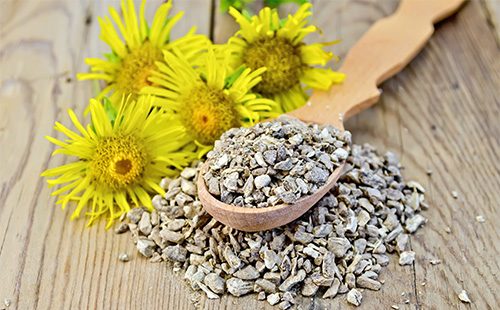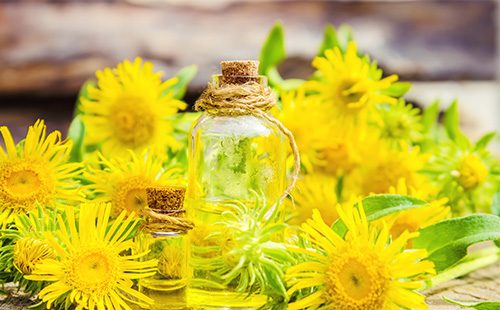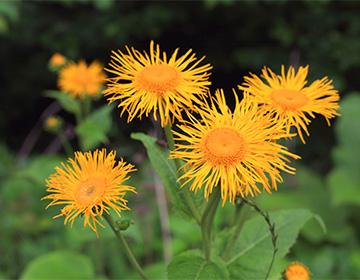The content of the article
Elecampane (yellow) is a genus of perennial herbaceous plants of the Astrov family, widely distributed in Europe, Asia and Africa. It unites more than 20 cultures, the most famous of which are elecampane high and cremoid. The first is recognized as a typical species and is used in traditional medicine.
Mention of its use dates back to the period of Ancient Greece. In ancient sources, the plant is called Inula helenium, and the species definition of helenium is associated with the name of the daughter of Zeus Elena. According to legend, beautiful sunny flowers grew from her tears.
Botanical characteristic
They endowed grass with magical properties. On the eve of St. John's Day, July 7, the young men were advised to pick a flowering branch, wrap it in a rag and wear it for nine days. Then mash it into powder and sprinkle it with a bouquet, give it to the girl you like. It was believed that no beauty can resist the spell of a magical plant.
Description
It was no coincidence that the magical properties of elecampane were attributed, this grass is too luxurious, hardy and powerful. Its many-headed rhizome gives dozens of small and thin processes up to 50 cm long that hold tight to the ground, making it almost impossible to pull out a stem with a root.
The massive root system feeds one or several erect stems up to 1.5 m high with longitudinal vertical grooves. The stem is covered with hard whitish hairs, often planted with leaves. They are arranged alternately, elongated, lower ones very large (up to 50 cm long), spread out by wide lobes. Upper - smaller (10-30 cm in length), but the same oblong shape. The front surface of the leaves is bright green, slightly wrinkled, barely pubescent, and the reverse is gray, “felt”, velvety to the touch.
In July-September, the stem blooms, releasing "brushes" generously strewn with flower baskets. They are bright yellow, round, with a diameter of up to 8 cm. Closer to the center are the largest flowers, to the edges - their size is reduced. The cups are wrapped with leaf blades with pointed leaflets down.
Fruit ripening occurs in August-October, when smooth, dark-brown seeds 3-5 mm long crumble onto the ground from dried flowers. Each seed is equipped with a “fly” - dirty gray hairs that allow the fruit to fly long distances.
Elecampane prefers well-moistened soils, therefore it is found on the banks of rivers, lakes, in wet meadows.Adjacent to shrubs and trees, not too picky about sun exposure.
Collection and harvesting of raw materials
In folk medicine, the use of the root of the plant is common. It is harvested during the fruiting period, from August to October, before the onset of frost. Re-harvesting is carried out in early spring - in March, immediately after the appearance of the first leaves. If the plant has already released the stem, it is impossible to harvest the roots: during the drying process they will become flabby, the raw material will be considered poor-quality.
Dig out the whole root, along with the subordinate roots. The plant is dug in a circle with a radius of about 20 cm from the stem, deepening by 30 cm. The soil mass with the rhizome is pulled out, threshed, the soil remains cleaned, quickly washed in water. Cut thin roots with a diameter of up to 0.5 cm, leaving the main rhizome with thick roots. They are first chopped across to pieces 10-12 cm long, and then each part along several plates up to 2 cm thick.
The obtained raw materials are dried in the sun for three days, after which they are transferred to a room or under awnings, laid out in one layer for drying. In automatic chambers dried at temperatures up to 50aboutC. Raw is considered to be a raw material in which thick rhizomes harden, and thin ones become brittle.
Composition and properties
In Russia, the medicinal raw materials of this plant are normalized by the state standard, therefore, the composition and properties of elecampane are well studied and formulated. Active substances are revealed in it:
- essential oil (1-3%, containing sesquiterpene, alantolactone, alanton, resins);
- inulin (up to 44%);
- organic acids;
- saponins;
- traces of alkaloids.
5 functions of inulin
Inulin is one of the most interesting substances in the composition of the roots of a medicinal plant. This is a complex biologically active compound of high molecular weight glucofructosans. Once in the body, inulin remains almost completely in the intestine, where it performs five functions.
- Lowers blood sugar. Inulin molecules are able to “bind” glucose molecules to themselves, act like sorbents, the target of which is sugar. Each molecule attaches to itself several glucose molecules, preventing its absorption in the blood. A smaller volume of sugars enters the body than the actual amount consumed with food. And glucose uptake occurs with minimal involvement of insulin. This property makes elecampane useful in diabetes.
- Supports a healthy microflora. Inulin mass is not digested in the digestive system and is not absorbed in the intestines. It works similarly to prebiotics - it serves as food for beneficial lactobacilli. An increase in their numbers inhibits the unfavorable microflora, which in turn provides several positive results at once. The body’s speed and ability to absorb minerals from food: calcium, magnesium and iron. Lipid metabolism improves, blood cholesterol level is significantly reduced. The plant contributes to the weight loss of obese people due to metabolic disorders. In turn, reducing overweight reduces the risk of developing non-insulin-dependent type 2 diabetes and cardiovascular disease.
- Protects against cancer. Recent studies have shown that a numerical increase in bifidobacteria in the intestine is a prevention of cancer. This is indicated in the scientific work “Prospects for the use of inulin in medical and pharmaceutical practice” by specialists of Volgograd State Medical University O. Yu. Mitrofanova and A. V. Yanitskaya. Inulin reduces the risk of malignant cells, produces immunomodulators, folic acid and others B vitamins.
- Cleanses the intestines from toxins, disinfects. The sorption mass of inulin intensively absorbs toxins, toxins, and has a disinfecting property. For the intestine, it becomes an effective “cleaning agent” that does not capture the beneficial microflora, but actively removes pathogens.
- Produces bile. Elecampane does not have a direct choleretic effect, but this effect is observed when taking its drugs. It provides inulin by increasing the intensity and quality of bowel movements. Due to this, the outflow of bile into the duodenum is facilitated, which normalizes digestion.
Therapeutic practice
The composition of the medicinal plant gives it the corresponding pharmacological properties:
- anti-inflammatory;
- expectorant;
- antiseptic;
- anthelmintic.
According to A.P. Popov, the author of the collection “Medicinal Plants in Traditional Medicine”, the beneficial properties of elecampane are determined mainly by the content of alantolactone and terpenoids of the essential oil similar to it. Other substances expand the spectrum of the plant, giving choleretic with weak diuretic activity.
Digestion
The plant belongs to the most popular "gastric" herbs in the people:
- reduces intestinal motility;
- normalizes appetite;
- stimulates the production of gastric juice.
It is used for gastritis, gastroenteritis, pancreatitis, enterocolitis. Tincture of the plant is recommended for diarrhea of a non-infectious nature, it also stimulates appetite. With hemorrhoids, the herb is used as a hemostatic and anti-inflammatory agent.
The pharmaceutical industry, based on the extract of Elecampane High, produces the drug Alanton. It is used to treat peptic ulcer of the stomach, duodenum and erosive gastritis. It has anti-inflammatory, capillary-strengthening actions, accelerates the regeneration of mucous membranes affected by the inflammatory process. There is evidence that sesquiterpene lactones of a medicinal plant have direct inhibitory activity against Helicobacter pylori, a bacterium that causes ulcerative destruction of the gastric and duodenal mucosa.
Respiratory system
The plant is recommended for wet cough with sputum difficult to separate. A decoction helps well in acute conditions and chronic processes:
- tracheitis;
- bronchitis with an abundance of mucus in the airways;
- pulmonary tuberculosis.
Assign it with suffocation and whooping cough.
The effectiveness of the plant against cough is scientifically confirmed. In 2013, on the basis of the National Medical University. A. A. Bogomolets in Ukraine conducted a large-scale study of the pharmacological aspects of the use of plant materials. The author of the study, an employee of the Department of Pharmacognosy and Botany A.Butko noted that in modern clinical practice, phytoculture is used for diseases of the respiratory system, mainly in complex preparations. This avoids side effects, as well as increase the biological activity of the main active substance.
Genitourinary system
There is a practice of using elecampane rhizomes for the treatment of diseases of the genital area in men: prostatitis, prostate adenomas. But to a greater extent, grass is known as "female." From ancient times, culture has been used to normalize menstruation. It allows you to establish a cycle disrupted by inflammatory processes, although it does not have a phytoestrogenic effect.
In the work of researchers V.F. Korsun, Ya. S. Kosovan, published in 2014, it is noted that women were given broth in Russia to eliminate pain in the uterus. Its anti-inflammatory, antispasmodic properties facilitated the condition due to a pronounced tone, an inflammatory reaction.
Recommended elecampane with hypomenstrual syndrome - amenorrheawhen the delay is associated with the individual physiological characteristics of the woman, suffered stress, inflammatory processes of the genitourinary system.
Skin, oral cavity
The anti-inflammatory properties of the herb are used in the treatment of skin diseases: psoriasis, eczema, intense seborrhea with severe grease, other diseases of a non-infectious nature.
External treatments help with gum inflammation, as well as skin lesions and injuries that are not accompanied by weeping, but do not heal for a long time.

Contraindications
High therapeutic value makes the culture extremely popular in folk medicine. However, plant contraindications limit its "free" use. These include:
- pathology of the cardiovascular system;
- severe kidney disease;
- pregnancy.
Herbalists say that despite the obvious advantages of the plant, caution should be exercised with it. So the author of more than 100 books on herbal medicine N.I. Maznev noted that it should be taken only as prescribed by the doctor, and childhood was also considered a contraindication.
Prescription Drugs
Water and water-alcohol forms of medications based on culture rhizomes and fat-based ointments are common in the people.
Water infusion
Features. Means with a low concentration of active components. As a result of infusion of rhizomes, a smaller volume of bioactive substances passes into water than when boiling. Therefore, it can be taken in the form of tea for colds, accompanied by inflammation, cough, bronchitis, tracheitis.
How to make and take
- Pour 20 g of rhizomes into a container.
- Pour in 400 ml chilled boiled water.
- Leave to brew for eight hours.
- Take 100 ml four times a day between meals. To improve the taste and support the body in case of illness, add honey.
The broth is weak
Features. Means for facilitating sputum discharge in inflammatory diseases of the upper respiratory tract, difficult, wet cough, profuse sputum, chest heaviness, pain when inhaling.
How to make and take
- Grind the rhizomes, pour a tablespoon into the container.
- Pour boiling water with a volume of 250 ml.
- Bring to a boil, simmer for 15 minutes.
- Drain the broth, cool.
- Every two hours, drink a tablespoon of the product in a warm form until relief occurs.
Strong broth (anti-inflammatory)
Features. A universal remedy for the treatment of diseases of the respiratory, digestive system, genitourinary sphere in men and women. It is used for cough, pancreatitis, peptic ulcer, gastritis, enterocolitis. External treatments, compresses help in healing wounds, reduce pain and inflammation in arthritis, rheumatism.
How to make and take
- Pour 20 g of chopped rhizomes into a container.
- Pour a glass of hot water.
- Bring to a boil, simmer under a lid for five minutes.
- Wrap the container, leave to brew for four hours.
- Strain.
- Take in a tablespoon four times a day half an hour before meals. Rinse the gums, mouth, throat with sore throat, stomatitis, and other inflammatory diseases. To treat joints, apply to clean tissue and apply compresses warm to painful areas.
Alcohol tincture
Features. It has a similar effect with a strong decoction, it is used in inflammatory processes of the respiratory organs, female diseases, and gastrointestinal disorders. It is subject to long storage.
How to make and take
- Grind 20 g of rhizomes, pour into a container.
- Pour alcohol with a strength of 70% in a volume of 100 ml.
- Leave in a dark place, warm for ten days.
- Shake the container daily.
- Strain.
- Take orally 20 drops three times daily before meals.

Ointment
Features. The tool is intended for the treatment of skin diseases of a non-bacterial nature, without inflammation and wetting elements. It is indicated for eczema, psoriasis, allergic spots, rashes, dermatitis. Keep the composition in the refrigerator, and cook in small portions, as it loses its properties after a week.
How to make and use
- Pass the rhizome through a meat grinder.
- Take a tablespoon of raw materials.
- Mix with five tablespoons unsalted lard.
- Heat over low heat for 15 minutes.
- Strain the product hot through a thick cloth.
- Lubricate the affected areas of the skin with the obtained ointment once a day until healing.
Do not use elecampane preparations beyond the prescribed period, do not exceed the dosage. Bioactive complex with accumulation in the body can cause intoxication.

